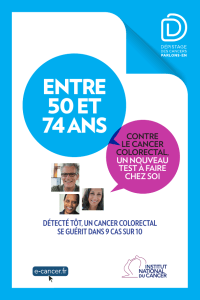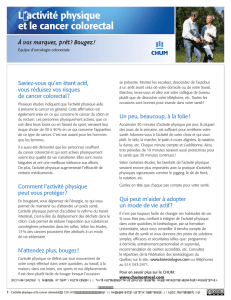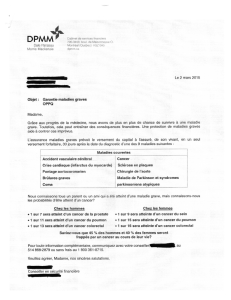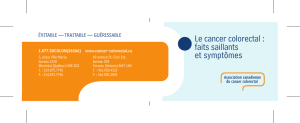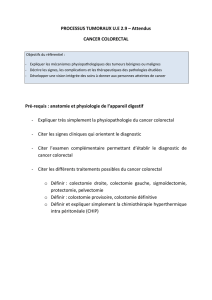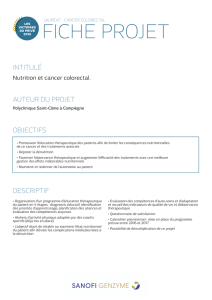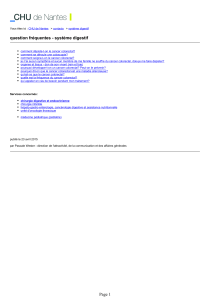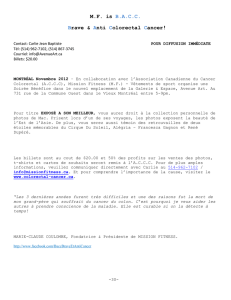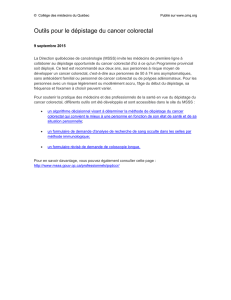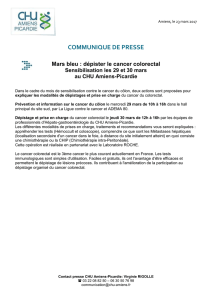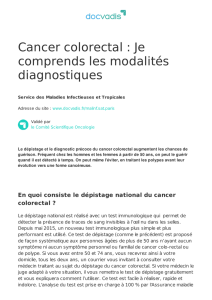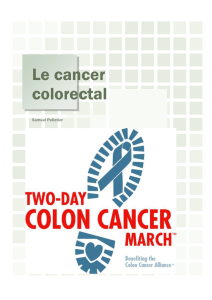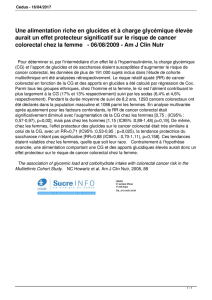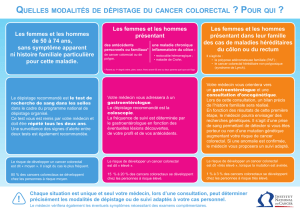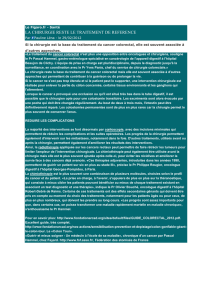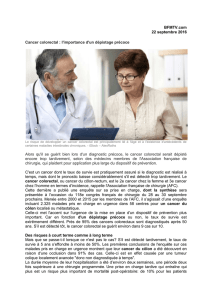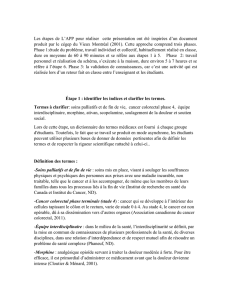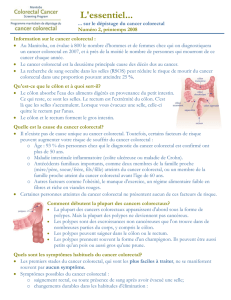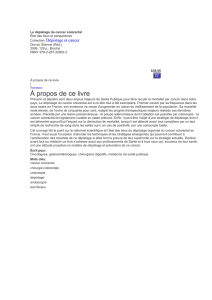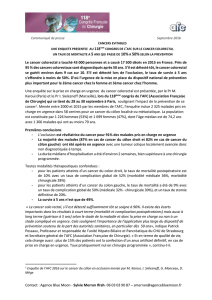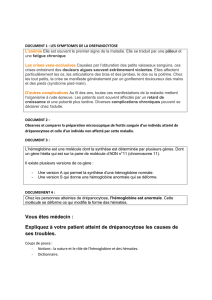HEMOTEST
publicité
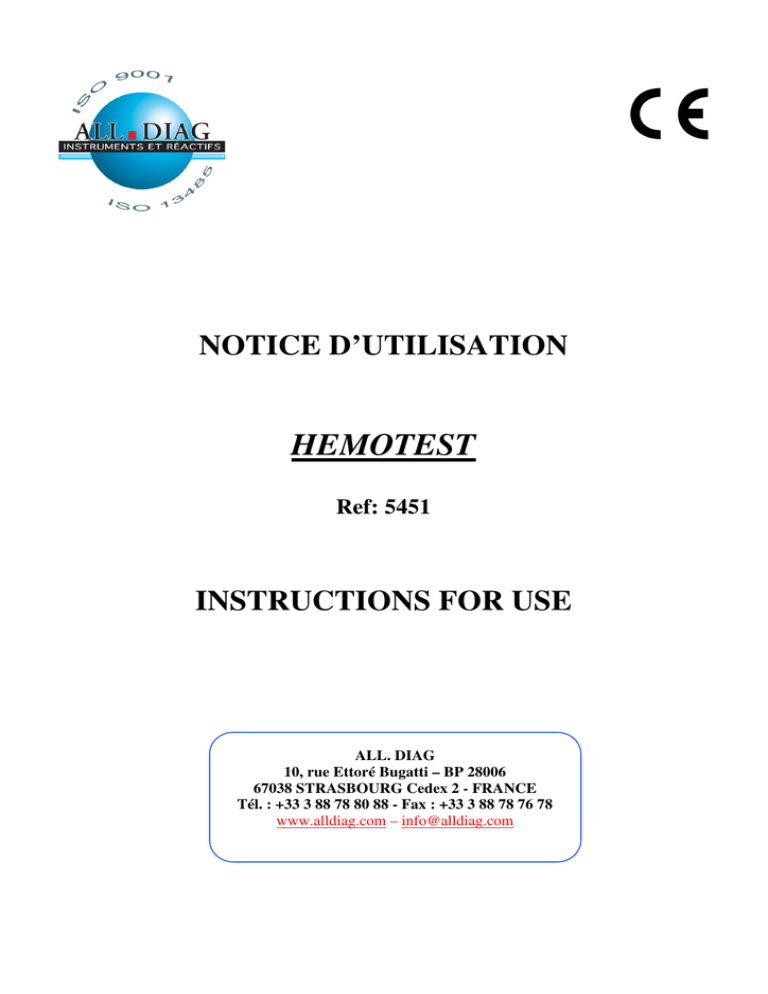
NOTICE D’UTILISATION HEMOTEST Ref: 5451 INSTRUCTIONS FOR USE ALL. DIAG 10, rue Ettoré Bugatti – BP 28006 67038 STRASBOURG Cedex 2 - FRANCE Tél. : +33 3 88 78 80 88 - Fax : +33 3 88 78 76 78 www.alldiag.com – [email protected] Liste des Symboles Attention, voir notice d’utilisation Tests par coffret Fabricant Pour diagnostic in vitro uniquement Péremption Usage unique Conserver entre 4-30°C No. de lot 30°C REF Code produit 4°C Index of Symbols Attention, see instructions for use Tests per kit Manufacturer For in vitro diagnostic use only Use by Do not reuse Store between 4-30°C Lot Number 30°C 4°C REF Catalog # Directive 98/79/CE Fabriquant / Manufacturer Version 10 – Mise à jour le 20/11/2006 ALL. DIAG 10, rue Ettoré Bugatti – BP 28006 67038 STRASBOURG Cedex 2 - FRANCE Tél. : 03 88 78 80 88 - Fax : 03 88 78 76 78 www.alldiag.com – [email protected] HEMOTEST Trousse de détection de l’hémoglobine humaine dans les selles Réf. 5451 Pour diagnostic in vitro. 1- INTRODUCTION La méthode au gaiac développée par Van Deen en 1864 a permis de détecter des traces de sang dans des milieux divers. Dès 1908, Boas utilisa cette méthode pour la mise en évidence de saignement occulte dans les selles. Depuis de nombreux progrès basés sur la mise en évidence de l’activité péroxydasique de l’hème ont été réalisés. Néanmoins les tests au gaiac impliquent l’exclusion de certains aliments, médicaments et vitamines, avant et pendant la période de recueil des selles. Certains auteurs ont également constaté que chez des patients atteints de cancers colorectaux ou d’adénomes, le test au gaiac était négatif par manque de sensibilité. Les développements respectifs des méthodes d’agglutination au latex (Adams et al., 1974), d’immunodiffusion radiale (Songster et al., 1980) et d’hémagglutination reverse (Scito et al., 1984) ont permis la mise au point de tests plus sensibles de détection de l’hémoglobine humaine dans les selles. Des études cliniques ont montré que les tests au gaiac donnent des résultats positifs dans 50 à 60% des cas de cancers colorectaux et seulement 25 à 35% des cas de polypes. De nouvelles méthodes de détection du sang dans les selles sont donc particulièrement intéressantes pour améliorer le diagnostic et le traitement des maladies à l’origine de saignements occultes. HEMOTEST a été développé pour mettre en évidence des quantités de sang dans les selles non détectable par les méthodes au gaiac. Ce test est spécifique de l’hémoglobine humaine et ne nécessite aucun régime ou restriction particulière avant le test. 2- PRINCIPE DU TEST HEMOTEST est un test immunochromatographique sur membrane utilisant une méthode sandwich de capture. HEMOTEST contient une combinaison de deux anticorps monoclonaux. Un anticorps monoclonal est conjugué à de l’or colloïdal, et un second anticorps monoclonal est fixé à la membrane. Si l’échantillon de selles contient de l’hémoglobine, celleci va se lier à l’anticorps marqué à l’or colloïdal et le complexe va migrer le long de la membrane au niveau de la zone test T. Au niveau de la zone CONTROL ″ C ″, l’anticorps marqué va former une bande de contrôle lorsque le test sera terminé. En 5 minutes ou moins, des quantités d’hémoglobine humaine supérieures ou égales à 20 µg Hb/g de selles sont détectées. 3- COMPOSITION DE LA TROUSSE 1. 2. 3. 20 sachets aluminium contenant les savonnettes ainsi qu’un sachet déssicant. Chaque savonnette contient une membrane de nitrocellulose coatée au niveau de la zone CONTROL « C » avec un anticorps de chèvre anti souris et au niveau de la zone TEST « T » avec un anticorps monoclonal de souris anti hémoglobine humaine. Un second anticorps monoclonal anti hémoglobine humaine est marqué à l’or colloïdal et est situé au dessus du puits échantillon « S ». 20 tubes collecteurs contenant un tampon de dilution. Une notice d’utilisation. 4- MATERIEL NON FOURNI Chronomètre 5- CONSERVATION ET PEREMPTION Les sachets aluminium contenant les savonnettes doivent être conservés à température ambiante, entre 4°C et 30°C. Si ils sont conservés au réfrigérateur attendre que la savonnette revienne à température ambiante avant d’ouvrir le sachet aluminium. Eviter d’exposer la trousse au chaud ou au froid. NE PAS CONGELER. Ne pas utiliser au-delà de la date de péremption indiquée sur le coffret. 6- PROCEDURE 1. 2. 3. 4. 5. Recueillir un échantillon de selles fraîchement émises dans un récipient propre. Dévisser le capuchon violet du tube collecteur et sortir la tige de recueil. Introduire la tige dans l’échantillon de selles à 6 endroits différents. Si besoin, retirer l’excès de matières fécales déposé sur la tige avec une serviette en papier. Replacer le capuchon violet et visser hermétiquement. L’échantillon ainsi préparé peut être conservé au réfrigérateur (2°C à 8°C) avant la réalisation du test. All Diag -1- Version 10 6. 7. Agiter énergiquement le collecteur avant d’effectuer le test afin de remettre en suspension. Sortir la savonnette de son sachet aluminium et la poser sur une surface horizontale et plane. Maintenir le tube vertical avec le capuchon violet vers le haut. Couper l’extrémité de l’embout violet à la main. Déposer 2 à 3 gouttes dans le puits “ S ” par pression sur le corps du tube collecteur. Lire le résultat au bout de 5 minutes. Ne pas lire après 10 minutes. 8. 9. Capuchon Tube collecteur 2 1 3. Prélever à 6 endroits différents 4 5 8 7 7- RESULTATS POSITIF : Deux bandes colorées mauves sont visibles au niveau de la zone TEST “ T ” et de la zone contrôle “ C ”. L’échantillon contient de l’hémoglobine humaine. NEGATIF: Une seule bande colorée mauve apparaît au niveau de la zone CONTROL “ C ”. L’échantillon ne contient pas d’hémoglobine humaine en quantités détectables par le test. Note : Si aucune bande colorée n’apparaît au niveau des zones “ T ” et “ C ”, le test n’a pas fonctionné correctement. Il faut recommencer à partir d’une nouvelle savonnette. De même, le test n’est pas validé si seule une bande apparaît au niveau de la zone Test « T ». 8- CONTROLE DE QUALITE Un contrôle de procédure interne est intégré au test (bande de contrôle « C »). Cela permet de contrôler que le volume de tampon est suffisant et que la procédure a été suivie correctement. L’absence de bruit de fond sur la membrane sert de contrôle négatif de procédure interne : Si un bruit de fond important (coloration mauve importante dans la fenêtre résultat) apparaît et empêche une bonne lecture, le résultat doit être considéré comme non significatif. Il est recommandé d’utiliser des contrôles positifs et négatifs pour vérifier les performances du test sur toute nouvelle livraison. 9- CONDITIONS DE CONSERVATION DE L’ECHANTILLON Les selles à analyser doivent être fraîchement émises. On peut conserver les selles 3 jours à 2-8°C ou 24 heures à température ambiante. L’hémoglobine humaine contenue dans les selles reste stable dans ces conditions. Une fois l’échantillon de selles dilué dans le tube collecteur, le mélange peut être conservé 7 jours entre 2°C et 8° C. All Diag -2- Version 10 10- PRECAUTIONS Ne pas utiliser le test au-delà de la date de péremption. Suivre les instructions avec précautions. Pour usage “ in vitro ” uniquement. Ouvrir le sachet juste avant la réalisation du test. Inscrire le nom et le numéro de dossier du patient directement sur la savonnette. Pour minimiser le risque d’apparition d’effet crochet, il est recommandé de ne prélever qu’une petite quantité de selles (de la taille d’une tête d’épingle) en présence de selles sanglantes ou noires. Ne pas manger, boire ou fumer lors de la manipulation des échantillons et du test. Se munir d’une blouse, de gants et de protection oculaire lors de la réalisation du test. Eviter les éclaboussures et formation d’aérosol. L’humidité et la température peuvent affecter le résultat du test. Les échantillons peuvent être contaminés par des agents infectieux. Considérer le matériel directement en contact avec les échantillons comme des produits contaminés. Traiter ensuite les différents éléments du test et les échantillons selon la procédure réservée aux déchets potentiellement infectieux. 11- LIMITES DU TEST 1. 2. 3. 4. HEMOTEST est un diagnostic complémentaire pour le médecin. Il ne peut se substituer à l’examen clinique ainsi qu’à la fibroscopie, l’endoscopie ou à la coloscopie. HEMOTEST ne détecte pas les faibles concentrations d’hémoglobine (<0,2 µg/mL de tampon ou <20µg/g de selles). Certaines pathologies intestinales (polypes, cancers colorectaux) peuvent entraîner des saignements intermittents ou même parfois aucun saignement. Le sang peut aussi ne pas être réparti de façon uniforme dans les selles. Ainsi un test peut être négatif même en présence d’une pathologie. En cas d’hémorroïdes ou d’hématurie ou pendant la période des règles, de faux résultats positifs peuvent être obtenus. Le recueil de l’échantillon doit être éloigné de plus de trois jours des périodes menstruelles. L’alcool, l’aspirine ou d’autres médicaments irritants pour l’appareil gastro-intestinal peuvent provoquer des saignements. Leur prise doit être arrêtée au moins 48 heures avant le recueil des selles. Des résultats positifs peuvent être liés à des pathologies autres que polypes et cancer colorectal (maladie de Crohn, Rectocolite hémorragique, diarrhées infectieuses, diarrhées parasitaires) 12- PERFORMANCES 1. 2. Sensibilité La sensibilité analytique d’HEMOTEST est : 0,2µg d’hémoglobine/mL de tampon ou 20 µg d’hémoglobine/g de selles. Spécificité HEMOTEST est spécifique de l’hémoglobine humaine. Des échantillons positifs et négatifs contenant les substances suivantes ont été testées sans interférence sur le résultat du test. SUBSTANCE Hémoglobine de poulet Hémoglobine de porc Hémoglobine de vache Hémoglobine de chèvre Hémoglobine de cheval Hémoglobine de lapin Péroxydase CONCENTRATION 500 µg/ml 500 µg/ml 500 µg/ml 500 µg/ml 500 µg/ml 500 µg/ml 2000 µg/ml 3. Etude de charge Une étude de charge a montré l’absence d’effet crochet jusqu’à une concentration de 2.5 mg d’hémoglobine/ml de tampon de dilution. 4. Reproductibilité Des échantillons positifs et négatifs ont été testés dans des essais multiples sans qu’aucune discordance n’apparaisse. 5. Corrélation Dans une étude clinique, 100 échantillons ont été testés avec HEMOTEST et HEMOTOP. 53 échantillons positifs et 47 échantillons négatifs ont été identifiés avec les deux tests. HEMOTOP + + 53 0 HEMOTEST 0 47 6. Evaluation dans le cadre d’un dépistage généralisé L’HEMOTEST a été évalué dans le cadre d’une campagne de dépistage de masse sur une population de 26 827 personnes de plus de 30 ans dans les environs de Pékin (République populaire de Chine). 19 852 personnes se sont soumises entièrement à la campagne de dépistage soit un taux d’adhésion de 74%. L’âge médian de la population étudiée était de 50 ans. 501 personnes ont été trouvées positives en HEMOTEST soit un taux de positivité de 5.6% contre 35.36% pour un test au gaïac. Les 501 personnes positives en HEMOTEST ont toutes eu une coloscopie. Des lésions positives ont été trouvées chez 77.8% d’entre elles. All Diag -3- Version 10 Le tableau ci-dessous résume les différentes pathologies rencontrées : NATURE DES LESIONS OBSERVEES EN COLOSCOPIE Pathologie Nombre de cas Cancer colorectal 14 Adénome 41 Polype inflammatoire 17 Polype indéfini 127 Polype prolifératif 3 Rectocolite hémorragique 17 Colite chronique 107 Mélanopathie colique 5 Diverticule colique 3 Hémorroïde 51 Fissure anale 4 Angiome télangiectasique 1 Colon normal 111 Sur 12 cas de cancers colorectaux analysés, 4 étaient au stade Dukes A, 7 au stade Dukes B et et 1 au stade Dukes C. Une sous population à risque a été identifiée selon les critères suivants : antécédents familiaux de cancer colorectal, cancer colorectal ou adénome préexistant, cholécystectomie de plus de 10 ans, rectocolite hémorragique sévère de plus de 10 ans, rectorragie de cause inconnue. Dans la population à risque, 2 cancers colorectaux (soit 0.28%) ont été identifiés. Dans la population sans risque connu, 12 cas de cancers colorectaux ont été identifiés (soit 0.05%). 1.07% des résultats HEMOTEST positifs correspondaient à un cancer colorectal. 91,66% des cas de cancers détectés par HEMOTEST étaient à un stade précoce ou relativement précoce. Ceci démontre l’intérêt de l’HEMOTEST comme moyen de dépistage précoce du cancer du colon plus sensible et spécifique que le test au gaïac. 13- VALEURS DE REFERENCE Des études16,17 utilisant un marquage des hématies au 51Cr ont montré qu’il existe un saignement physiologique chez les sujets sains correspondant à un volume de 0.5 à 2 ml par jour. En considérant un volume de selle moyen par jour de 150 g ; un saignement physiologique peut correspondre jusqu’à 2mg d’hémoglobine par gramme de selle. Un test HEMOTEST positif peut permettre une prise en charge précoce d’un cancer colorectal mais ne permet pas à lui seul de diagnostiquer et d’identifier l’origine d’une pathologie. 14- BIBLIOGRAPHIE 1. Boas, I. ″Uber Okkulte Magenblutungen,″ Dtsch. Med. Wochenschr, Vol. 27 (1901) : 315-21. 2. Van Deen, J. ″Tincture Guaijaci, Und ein Ozontrager, Als reagens auf Sehr Geringe Blutmengen, Namentlich in Medicoforensischen Fallen,″ Arch. Holland Beitr Natura Heilk, Vol. 3 (1864) : 288-3.3. 3. Adams, E.C. and Layman, K.M. ″Immunochemical Confirmation of Gastrointestinal Bleeding,″ Ann. Elin. Lab. Sci., Vol. 4 (1974) : 343. 4. Saito, H. et al. ″An Immunological Occult Blood Test for Mass Screening of Colorectal Cancer by Reverse-Passive Hemagglutination (RPHA),″ Japanese Jurnal of Gastroenterology, Vol. 81 (1984) : 2831. 5. Simon, J. B. ″Occult Blood Screening for Colorectal Carcinoma : A Critical Review,″ Gastroenterology, Vol. 88 (1985) : 820. 6. Heinbrich, H.C. ″Ultrasensitiver Immunochemistery Okkulblutnachweis im Stuhl,″ in Fruhmorgen, P. (ed), Pravention und Fruherkennung des Lolorektalen Karzinoms, 1st Edn. (Springer, Berlin, Heidelberg : New York, 1984), pgs 59-82. 7. Mancini, G., Carbenara A.O., and Heremans J.F. ″Immunochemical Quantitation of Antigens by Single Radial Diffusion,″ Immunochemistery, Vol. 2 (1965) : 235-54. 8. Ribet, A., Frexinos, J., and Escourrou, J. ″Occult-blood Test and Colorectal Tumors,″ Lancet, Vol. 1 (1980) : 417. 9. Schwartz, S., Dahl, J., Ellefson, M., and Ahlquist, D. ″The Hemo Quant’Test : A Specific and Quantitative Determination of Heme (Hemoglobin) in Feces and Other Materials,″ Clin. Chem. Wochenschr, Vol. 29 (1983) : 2061-67. 10. Songster, C.L., Barrows, G.H., and Jarret, D.D. ″Immunochemical Detection of Fecal Occult Blood. The Fecal Smear Punch-Disk Test : A New Non-Invasive Screening test for Colorectal Cancer,″ Cancer, Vol. 45 (1980) : 1099-1102. 11. Taranen, M.J., Lienwendahl, K., Partanen, P., and Aldercreutz, H. ″Immunological Detection of Fecal Occult Blood in Colorectal Cancer,″ Br. J. Cancer, Vol. 49 (1984) : 141-48. 12. Winawer, S.J. ″Screening for Colorectal Cancer : An Overview,″ Cancer, Vol. 45 (1980) : 1093-98. 13. Launoy, G., Herbert, C. ″Dépistage de masse du cancer colorectal. L’état actuel en France,″ In : Prévention, dépistage et prise en charge des cancers du colon. Texte des experts.29-30 janvier 1998, 19 pages. 14. Kronborg, O. et al. ″Randomised Study of Screening for Colorectal Cancer with Faecal-Occult-Blood-Test,″ Lancet, Vol. 348 (1996) : 1467-1471. 15. Tazi, M.A. et al. ″La recherche de saignements occultes dans les selles permet-elle de réduire la mortalité par cancer colorectal ? Résultats d’une étude cas-témoins,″ Gastronterol. Clin. Biol. Vol. 22 (1998) : A188. 16. Cameron, A.D. Gastro-intestinal blood loss measured by radioactive chromium. Gut Vol. 1 (1960) : 177-82. 17. Ebaugh F.G. Jr., Clemens, T., Rodnan, G., et al. Quantitative measurement of gastrointestinal blood loss. The use of radioactive Cr51 in patients with gastrointestinal hemorrhage. J. Am. Med. Vol. 25 (1968) : 169-181. All Diag -4- Version 10 HEMOTEST HEMOTEST immunological FOB test is a rapid, convenient and odourless qualitative, sandwich dye conjugate immunoassay for the determination of human occult blood in faeces, and is a useful aid in the diagnosis and therapy of gastrointestinal disorders. Réf.: 5451 For in vitro diagnostic use only 1- INTRODUCTION The guaiac method was developed by Van Deen in 1864 to detect occult blood. Boas began to use this method in 1901 to diagnose gastric bleeding. Since that time, numerous improvements have been introduced which utilize the peroxides activity of heme. However, in order to get accurate test results, guaiac based tests require that certain foods, drugs, vitamins and other substances should be avoided before and during the sample collection period. Several authors have also found that some patients with colorectal cancer or adenoma tested negative for occult blood because of the lack of sensitivity of guaiac based methods. Subsequent development of latex immunochemical agglutination and of the single radial immunodiffusion(SRID) and of the reverse-passive hemagglutination(RDHAA)have produced test methods more sensitive to low concentrations of human occult blood in faeces. The results of clinical studies indicate that test results are positive in only about 50-60 percent of patients with colorectal cancers and only 25-30 percent of patients with polyps. Therefore, a more sensitive means for detecting faecal occult blood is important for the diagnosis of diseases that result in gastrointestinal bleeding. HEMOTEST lmmunological FOB test actually detects lower levels of fecal occult blood than the standard guaiac tests by employing an immunospecific, double-sandwich capture method without any restriction on foods and drugs. 2- PRINCIPLE HEMOTEST lmmunological FOB test is a qualitative, sandwich dye conjugate immunoassay and employs a unique combination of monoclonal and polyclonal antibodies to selectively identify haemoglobin in test samples with a high degree of sensitivity. In less than five minutes, elevated levels of human haemoglobin as low as 20 µgHb/g of faeces can be detected and positive results for high levels of haemoglobin can be seen in the test as early as one or two minutes. As the test sample flows up through the absorbent device, the labelled antibody-dye conjugate binds to the haemoglobin in the specimen forming an antibody-antigen complex. This complex binds to anti haemoglobin antibody in the positive test reaction zone and produces a pink-rose color band. In the absence of haemoglobin, there is no line in the positive test reaction zone. The pink-rose color bands in the control reaction zone demonstrate that the reagents and devices are functioning correctly. 3- KIT COMPONENTS 1. 20 aluminium bags, containing a device and a desiccant. Each device contains a membrane of nitrocellulose, coated at the level of the “C” CONTROL zone, with a goat antibody anti mouse allergens and at the level of the “T” test zone, with a monoclonal mouse anti body anti human haemoglobin. A second monoclonal antibody anti human haemoglobin is marked with colloidal gold and situated over the “S” sample well. 2. 20 collecting tubes, containing a dilution buffer. 3. 1 instruction for use 4- NON FURNISHED COMPONENTS A chronometer 5- STORAGE AND EXPIRATION The aluminium bags, containing the devices must be kept at room temperature, between 4°C and 30°C. If kept in refrigerator, wait until they have reached room temperature before opening the aluminium bag. Avoid exposing the kit to cold or hot temperatures. DO NOT FREEZE. Do not use past the expiration date, indicated on the box. 6-PROCEDURE 1. 2. 3. 4. 5. 6. Collect a fresh stool sample collected in a clean container, Loosen the purple cap of the specimen collection tube and remove the applicator stick, Introduce the applicator stick into the stool sample at 6 different sites so as to get sampling even at spirals, If need be, remove excess stool residue on stick, with a paper tissue, Replace the purple cap and screw it back on hermetically. In this way, the sample can be kept in the refrigerator (2°C to 8°C), before the test, Shake the tube so as to suspend the liquid in the tube, All Diag -5- Version 10 7. Remove the “reaction device” from its foil wrapper by tearing along the “slice”; and place it on a flat, horizontal surface. Maintain the tube in a vertical position with the purple cap upwards. Cut the tip of the purple cap, Dispense 2 to 3 drops in the “s” well by applying pressure to the collection tube, Read results within 5 minutes. Do not read after 10 minutes. 8. 9. Cap Collector tube 3. introduce at 6 different sites 2 1 4 5 8 7 7- RESULTS Positive: One band appearing in the “C” region, the other in the “T” region, the blood occult is positive; (see A) Negative: Only one color band appearing in the “C” region, the blood occult is negative; (see B) Invalid: No color bands appearing in the window at all, the test result is invalid. (see C) A B C Notes: • Do not drop fecal sample liquid into result windows; • Read results within 5 minutes. Do not read results after 10 minutes; • Period is 18 months and do not use products after expiration date; • Sample collection tube after collecting sample should be stored refrigerated (2°C-8°C) if not used immediately. Store test strip at 2°C-30°C (room temperature). • Avoid internal use and children touching. 8- QUALITY CONTROL An internal control procedure is integrated to the test (control band “C”). This helps control whether the buffer volume is sufficient and that the procedure has been correctly followed. The absence of a back-ground on the membrane shows a negative result of the internal procedure: if an obvious back-ground (great purple coloration in the result window) appears and keeps from getting a good reading, the result must be considered as non significant. It is recommended to use positive and negative controls to verify the performance tests on every new delivery. 9- SAMPLE STORAGE The stool samples must be fresh. They can be kept for 3 days at a temperature from 2°C to 8°C or at room temperature for 24 hours. The Human haemoglobin in the faeces remains stable in these conditions. Once the faecal sample is diluted in the collecting tube, the mixture can be kept for 7 days at temperatures from 2°C to 8°C. All Diag -6- Version 10 10- PRECAUTIONS Do not use past the expiry date. Follow the instructions carefully. Only for in vitro use. Open the bag right before the test. Write the name and number of the patient’s file, directly on the device. In order to minimize hook effect it is recommended to take only a small stools sample (the size of a pin head) in the presence of bloody or black faeces. Do not eat, drink or smoke during the sample and test handling. Wear a smock, gloves and eye protection while testing. Avoid splashes and aerosol formation. Humidity and temperature can affect the results of the tests. The samples can be contaminated by infectious agents. Consider the material, put directly in contact with the samples, to be contaminated products. Treat the various test elements and samples as potentially infectious waste, by following the procedure instructions. 11- LIMITATION FOR THE PROCEDURE 1. 2. 3. 4. 5. As with any occult blood test, HEMOTEST may not be considered as a conclusive diagnosis for gastrointestinal bleeding or pathology, they can only be regarded as a preliminary screening or as an aid to diagnosis. They are not intended to replace other diagnostic procedures such as EGD, colonoscopy or other X-ray studies. HEMOTEST is a valuable aid in the early detection of colorectal bleeding device. However, since bowel lesions, including some polyps and colorectal cancers, may not bleed at all or may bleed intermittently, or the blood may not be uniformly distributed in a stool sample, a test result maybe negative even when disease is present. HEMOTEST results may be positive for samples from healthy patients. This may be because certain medications may cause gastrointestinal irritation resulting in gastrointestinal bleeding. In case of hemorrhoids or hematury or during the menstrual period, incorrect positive results can be obtained. Sample collection must be done at least 3 days before the beginning of menstruation. Alcohol, aspirin or other such gastro-irritant medicine can provoke bleeding. One should refrain from taking any such medicine at least 48 hours before collecting stool samples. 12- PERFORMANCES 1. 2. Sensitivity The analytic sensitivity of HEMOTEST is of 0.2 µg of haemoglobin/ml of buffer or 20µg of haemoglobin/g of faeces. Specificity HEMOTEST is specific to human haemoglobin. Positive and negative samples containing the following substances have been tested without interference on the test result. Substance Chicken haemoglobin Pork haemoglobin Cow haemoglobin Goat haemoglobin Horse haemoglobin Rabbit haemoglobin Peroxydase 3. 4. 5. Concentration 500µg/ml 500µg/ml 500µg/ml 500µg/ml 500µg/ml 500µg/ml 2000µg/ml Study of charge A study of charge shows the absence of the hook effect until a concentration of 2.5mg of haemoglobin/ml of dilution buffer. Reproducibility Positive and negative samples were tested in multiple essays without any apparition of discord. Correlation During a clinical study, 100 samples were tested with HEMOTEST and HEMOTOP. 53 positive samples and 47 negative samples were identified with both tests. HEMOTOP + - HEMOTEST 6. + 53 0 0 47 Evaluation in the case of generalized detection HEMOTEST was evaluated in the case of a mass detection campaign on a population of 26 827 people over 30 years old, in the area of Beijing (Popular Republic of China).19 852 people went entirely through the detection campaign, an adhesion rate of 74%. The median age of the group was of 50 years old. 501 people were tested positive to HEMOTEST, a positive rate of 5.6%, against 35.36% for a test on gaiac. The 501 people with positive results to HEMOTEST all got a coloscopy. Positive lesions were found in 77.8% of them. All Diag -7- Version 10 The following tabulation summarizes the various pathologies that were found: Nature of the lesions found in coloscopy Pathology Colorectal cancer Adenoma Inflammatory polyp Indefinite polyp Proliferate polyp Haemorrhagic rectocolite Chronic colitis Melanopathic colic Diverticule colic Haemorrhoid Anal crack Telangiectasic Angiome Normal colon Number of cases 14 41 17 127 3 17 107 5 3 51 4 1 111 Out of the 12 colorectal cancer cases, 4 were at stage Dukes A, 7 at stage Dukes B and 1 at stage Dukes C. A sub population at risk was identified with the following criteria: family antecedents of colorectal cancer, colorectal cancer or pre-existent adenoma, over 10 year old cholecystectomy, over 10 year old severe haemorrhagic rectocolite, unknown haemorrhage. Amongst the population at risk, 2colorectal cancers (0.28%) were found. In the know risk population, 12 cases of colorectal cancer were identified (0.05%). 1.07% of the positive HEMOTEST results corresponded to colorectal cancer. 91.66% of the cancer cases detected by HEMOTEST were at an early or relatively early stage. This shows the interest of HEMOTEST as being a way to detect early colon cancer, more sensitive and specific than the gaiac test. 13- REFERENCE VALUE Studies using the hematite Cr markings showed that there was physiological bleeding, in healthy subjects, that corresponded to a volume of 0.5 to 2 ml per day. Considering an average stool volume of 150g per day, a physiological bleeding can correspond to up to 2 mg of haemoglobin per gram of stool. A positive HEMOTEST can enable timely medical care of a colorectal cancer, but does not enable it to detect and identify the origin of a pathology, on its own. 14- BIBLIOGRAPHY 1. 2. 3. 4. 5. 6. 7. 8. 9. 10. 11. 12. 13. 14. 15. 16. 17. Boas, I. ″Uber Okkulte Magenblutungen,″ Dtsch. Med. Wochenschr, Vol. 27 (1901) : 315-21. Van Deen, J. ″Tincture Guaijaci, Und ein Ozontrager, Als reagens auf Sehr Geringe Blutmengen, Namentlich in Medicoforensischen Fallen,″ Arch. Holland Beitr Natura Heilk, Vol. 3 (1864) : 288-3.3. Adams, E.C. and Layman, K.M. ″Immunochemical Confirmation of Gastrointestinal Bleeding,″ Ann. Elin. Lab. Sci., Vol. 4 (1974) : 343. Saito, H. et al. ″An Immunological Occult Blood Test for Mass Screening of Colorectal Cancer by Reverse-Passive Hemagglutination (RPHA),″ Japanese Jurnal of Gastroenterology, Vol. 81 (1984) : 2831. Simon, J. B. ″Occult Blood Screening for Colorectal Carcinoma : A Critical Review,″ Gastroenterology, Vol. 88 (1985) : 820. Heinbrich, H.C. ″Ultrasensitiver Immunochemistery Okkulblutnachweis im Stuhl,″ in Fruhmorgen, P. (ed), Pravention und Fruherkennung des Lolorektalen Karzinoms, 1st Edn. (Springer, Berlin, Heidelberg : New York, 1984), pgs 59-82. Mancini, G., Carbenara A.O., and Heremans J.F. ″Immunochemical Quantitation of Antigens by Single Radial Diffusion,″ Immunochemistery, Vol. 2 (1965) : 235-54. Ribet, A., Frexinos, J., and Escourrou, J. ″Occult-blood Test and Colorectal Tumors,″ Lancet, Vol. 1 (1980) : 417. Schwartz, S., Dahl, J., Ellefson, M., and Ahlquist, D. ″The Hemo Quant’Test : A Specific and Quantitative Determination of Heme (Hemoglobin) in Feces and Other Materials,″ Clin. Chem. Wochenschr, Vol. 29 (1983) : 2061-67. Songster, C.L., Barrows, G.H., and Jarret, D.D. ″Immunochemical Detection of Fecal Occult Blood. The Fecal Smear Punch-Disk Test : A New Non-Invasive Screening test for Colorectal Cancer,″ Cancer, Vol. 45 (1980) : 1099-1102. Taranen, M.J., Lienwendahl, K., Partanen, P., and Aldercreutz, H. ″Immunological Detection of Fecal Occult Blood in Colorectal Cancer,″ Br. J. Cancer, Vol. 49 (1984) : 141-48. Winawer, S.J. ″Screening for Colorectal Cancer : An Overview,″ Cancer, Vol. 45 (1980) : 1093-98. Launoy, G., Herbert, C. ″Dépistage de masse du cancer colorectal. L’état actuel en France,″ In : Prévention, dépistage et prise en charge des cancers du colon. Texte des experts.29-30 janvier 1998, 19 pages. Kronborg, O. et al. ″Randomised Study of Screening for Colorectal Cancer with Faecal-Occult-Blood-Test,″ Lancet, Vol. 348 (1996) : 1467-1471. Tazi, M.A. et al. ″La recherche de saignements occultes dans les selles permet-elle de réduire la mortalité par cancer colorectal ? Résultats d’une étude cas-témoins,″ Gastronterol. Clin. Biol. Vol. 22 (1998) : A188. Cameron, A.D. Gastro-intestinal blood loss measured by radioactive chromium. Gut Vol. 1 (1960) : 177-82. Ebaugh F.G. Jr., Clemens, T., Rodnan, G., et al. Quantitative measurement of gastrointestinal blood loss. The use of radioactive Cr51 in patients with gastrointestinal hemorrhage. J. Am. Med. Vol. 25 (1968) : 169-181. All Diag -8- Version 10
